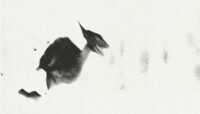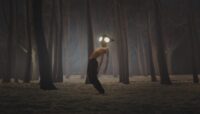
“Dying is Fine“
from the single Dying is Fine
2007
iTunes
Ra Ra Riot violinist Rebecca Zeller fondly recalls the rocky circumstances of her band’s first gig during the winter of 2006. It was in the basement of her off-campus house in Syracuse, before the fledgling group even had its first rehearsal. When Ra Ra Riot’s affable, easy-going drummer John Pike hadn’t materialized by show time, the band went on “stage” with a drum machine.
“He thought it was a practice and showed up an hour late,” Zeller says over the phone from New Orleans, where later that night Ra Ra Riot would open for Tokyo Police Club. “He had no idea it was a show, and when he arrived, there were probably about 200 people there and we were already playing. So he just stood there in the crowd and watched us, like everybody else. That was classic John.”
Zeller’s use of the past tense in talking about Pike is illustrative of the sad, jarring truth of the 23-year-old drummer’s tragic death, apparently by accidental drowning, last summer after a postshow party with friends. On June 1, Ra Ra Riot had played a show in Providence, previewing songs from its buzzed-about self-titled debut EP. Upon retiring to Fairhaven after the show, Pike vanished around 3 the next morning. A search party found his mobile phone on a nearby beach, and on June 3, officials and rescue teams dredging Buzzards Bay discovered Pike’s body.
Ra Ra Riot has decided to continue in the wake of his death, having booked a tour last summer and having been encouraged to do so by Pike’s family. Still, band members remain profoundly shaken by the loss of their drummer and friend who was, by their account, a gregarious presence who provided comedic relief to the sextet’s chemistry, both onstage and off.
“Obviously, there’s nothing I would rather have more than having John back and no success whatsoever,” says Zeller, 23. “It’s been crazy because as a group, we’ve only been together for a year and a half and there was so much good happening. And then all of a sudden, the worst possible thing that could ever happen happened, and it completely shattered our world. I don’t even know how to describe it except to say that I wish we could exchange everything we’ve had for John coming back. There’s not a day when we don’t think about him.”
Ra Ra Riot guitarist Milo Bonacci, 24, also wrestles with the reality of Pike’s absence but says the loss has strengthened the band’s bond and its resolve to pursue the plans its members hatched together. “We’ve used that whole incident as inspiration to keep going in some ways, and we’ve been trying to turn it into a positive thing, however we can,” Bonacci says. “Obviously, it’s very difficult doing something that you only know about doing with a close friend — and then suddenly not having them there anymore. At the same time, it seems like the only option. We were all convinced that this is what John would have wanted, and his family had been urging us to continue on. So we know it’s the right choice.”
Rarely has such triumph, and tragedy, struck a young pop band in such a ridiculously short span of time. Bonacci says he started the band in January 2006 with five friends and modest goals: “I wanted to do something that would be fun, where we could play around campus and play at house parties — and that sort of nurtured this upbeat, danceable style of music, I suppose. I wanted to gather as many instruments as possible and was thinking that the more of those there were, the more opportunities there would be for experimentation. I was curious about strings” — cue up violinist Zeller and cellist Alexandra Lawn — “and it all came together within a couple of weeks.”
Almost immediately, Ra Ra Riot, which also includes singer-keyboardist Wesley Miles and bassist Mathieu Santos (and, for now, Santos’s friend Mike Ashley filling in on drums), began getting noticed for its fiery, free-wheeling performances. The band soon had more shows than rehearsals. It opened for Art Brut and the Cribs and was tapped as the opening act on Editors‘ US tour in the fall.
British music publication NME hailed Ra Ra Riot as one of the 10 best bands to appear at the South by Southwest music conference and compared its live show to “Dexy’s Midnight Runners playing R.E.M.” In a May 20007 “On the Edge” column, Rolling Stone picked the group as an emerging artist, and described the debut EP as being “full of violins, cellos, and songs about not being afraid of death” — which, in hindsight, seems somewhat prophetic.
In fact, only one of the EP’s six tracks, the frothy, strings-and-percussion-driven “Dying is Fine,“ explicitly contemplates mortality. But given the powerful emotional responses that music can trigger, it’s not uncommon that audiences and critics alike might read deeper meanings into Ra Ra Riot’s songs in an attempt to make sense of such an incomprehensible catastrophe as Pike’s death.
“Because John was such a huge part of the songwriting process, some of the songs do remind us of everything that’s happened, and ‘Dying is Fine’ does take on a different meaning now,” Bonacci says. “But speaking for myself, everything we do as a band reminds me of John, and most of those things are happy, friendly reminders. Because it’s something we all had fun doing together.”


